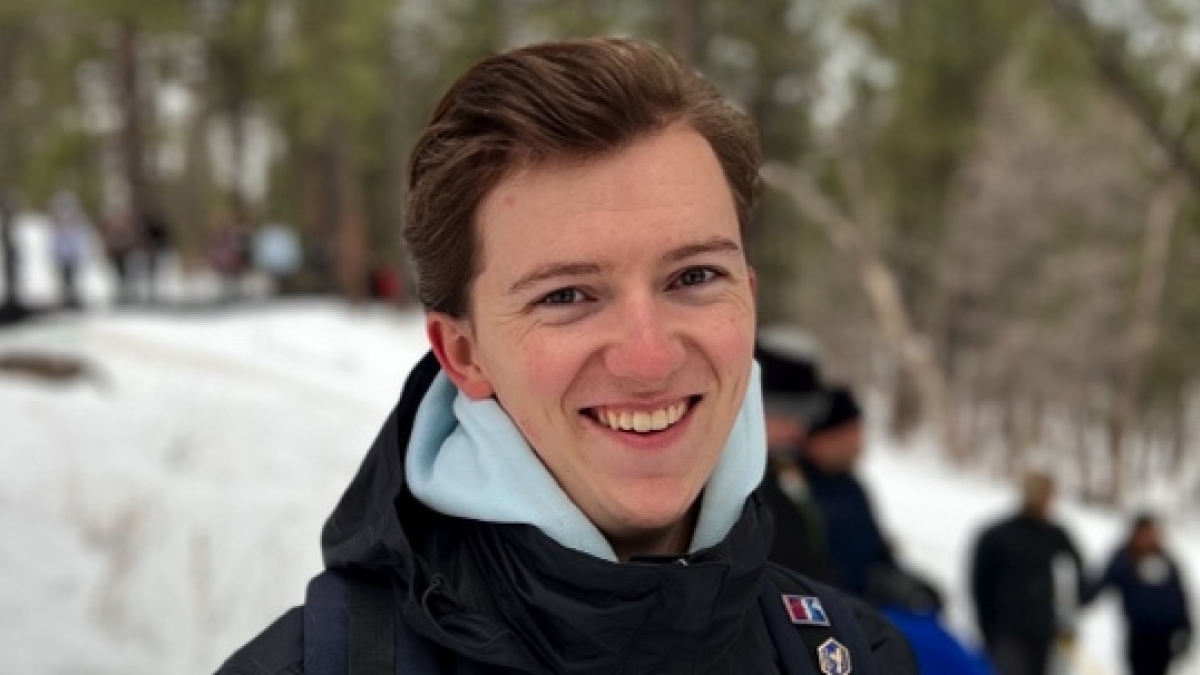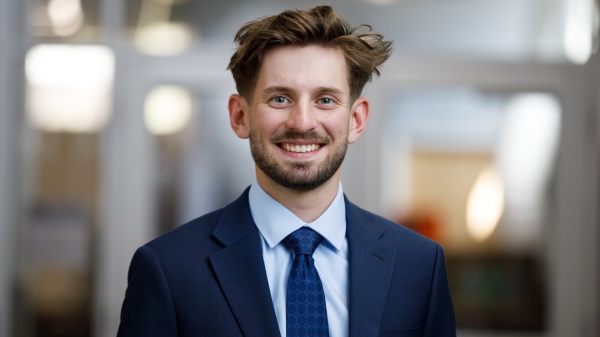Astrophysics graduate finds passion in education, community outreach

Alex Blanche will graduate with a Bachelor of Science in astrophysics from the School of Earth and Space Exploration.
Editor's note: This story is part of a series of profiles of notable spring 2023 graduates.
As Alex Blanche sat down to work on his career fair project in fifth grade, little did he know that the assignment would spark a lifelong passion for astrophysics. With a poster titled "Why I Want to be an Astronomer," Blanche’s fascination with space began to take shape and evolve into a career path.
An Arizona native, Blanche chose to stay closer to home to make his career fair project a reality at Arizona State University. Now, Blanche will graduate with a Bachelor of Science in astrophysics from the School of Earth and Space Exploration.
Over the course of his academic career, Blanche has worked closely with Regents Professor Rogier Windhorst, doing research on the Hubble Space Telescope.
“Alex Blanche has been superb in all things cosmology as well as SESE outreach. He has done innovative research on Hubble Space Telescope UV images of galaxies that are contributing to the reionization of the universe,” Windhorst said. “He has also been a truly superb TA for my AST 322 Cosmology course, helping make the homework (hardcore relativity!) better understandable and doable for the students. And Alex has been a triple black belt in many, many SESE outreach events.”
Together with his research, Blanche has also been extensively involved in SESE outreach activities, promoting science education and research to the wider community. Educating guests as a docent and presenter at the school, Blanche plans to use his experiences at ASU to pursue a career in education and community outreach.
“I’ve been so lucky to have caught the bug from all the wonderful members of the outreach team, and to be able to continue to explore and pass that on to others is something I’m incredibly excited about. I don’t know where just yet, but that’s another thing for me to discover!” Blanche said.
He shares insights on his ASU experience.
Question: What was your “aha” moment when you realized you wanted to study the field you majored in?
Answer: I don’t know when I first realized I wanted to study astrophysics; I’ve always been surrounded by the sciences. When I was little, I had posters of the solar system my parents put up for me. I was also a big fan of Buzz Lightyear, but space ranger isn’t a very common career path. My clearest memory was in fifth grade when we were assigned a career fair project; we picked a career, researched where to go to school and what people did in that career, and made a poster. I still have a poster in the closet of my parent’s house that says “Why I Want to be an Astronomer." I think it was sometime around then when my fascination with space became less of a decorating option and more of a career path.
Q: What’s something you learned while at ASU — in the classroom or otherwise — that surprised you or changed your perspective?
A: The biggest thing I learned here while at ASU was how to keep a healthy work-life balance. It’s hard to keep a clear head when you’re your own drill instructor. It’s how I spent most of my high school career, so coming to ASU, the intense college environment, and finding that balance was surprising. Being able to go easy on myself when I needed to and focus on things outside of academia helped me grow into the person I’m proud of today.
Q: Why did you choose ASU?
A: Definitely not because of the summers. In all honesty, I chose ASU at first because it was close. I knew people here, and being close to family and friends was important. Looking back, I don’t think I could’ve made a better decision. The opportunities I’ve had and the people I’ve gotten to meet have made my time here 100% successful.
Q: Which professor taught you the most important lesson while at ASU?
A: Dr. Rogier Windhorst was definitely the most influential professor I had during my time here. He was the first professor I talked to outside of class and the first to give me a chance as an undergrad in research. Although not intentionally, he taught me that professors aren’t as scary as my freshman-brain thought. I think I paced up and down the hall to his office for 10 minutes before eventually knocking on his door. He’s been a constant support and gave me opportunities that helped me get to where I am in my career today.
Q: What’s the best piece of advice you’d give to those still in school?
A: The best advice I have for anyone still in school is to go easier on yourself. You have to be kind to the person you’re always stuck with.
Q: What was your favorite spot on campus, whether for studying, meeting friends or just thinking about life?
A: My favorite spot on campus has to be the Marston Theater. I’ve been both a presenter and an audience member there, and it’s the coolest place to have to take a class on campus. Getting to watch the first images from the James Webb Space Telescope be streamed on the big screen is one of my favorite memories of my time here at ASU. But during the hot summer months, the AC full blast, you can nap in there for days (don’t tell Ric Alling). To me, it represents limitless scientific exploration and, more personally, comfort.
Q: If someone gave you $40 million to solve one problem on our planet, what would you tackle?
A: What would I tackle? Nothing larger than a dog; any bigger and I’d probably lose. As for the money, I think I’d want it to go towards funding education in underfunded communities. There are so many problems that I think deserve that $40 million and more, but education is something I’m so passionate about. I think there are too many instances where people fall through the cracks in our educational system. Whether it be better supporting teachers or making education more equitable, education could use the money. Everyone has the potential to become successful in something they love, but not everyone gets that chance. The more educated society is, the better.
Q: Any influences from past teachers, friends or family?
A: All of the above are my main influences. My parents encouraged my curiosity and learning from the very start; they’ve been nothing but supportive for every step and decision I’ve made so far. Without their guidance and upbringing, I doubt I’d be as passionate about the things I am. As for teachers, my biggest influences have to be Mrs. Baldwin and Mrs. Charnell, from my high school and elementary school, respectively, who supported and helped grow my interest in math and science. They saw potential in me beyond the bare minimum and always pushed me to reach for that. As for my friends, my No. 1 influence and inspiration has to be my lifelong friend Sarah, who always did the heavy lifting when I couldn’t. And of course, thank you to everyone else at SESE who were along for the ride, whether it be faculty, staff or my peers.
More Science and technology

Cracking the code of online computer science clubs
Experts believe that involvement in college clubs and organizations increases student retention and helps learners build valuable…
Consortium for Science, Policy & Outcomes celebrates 25 years
For Arizona State University's Consortium for Science, Policy & Outcomes (CSPO), recognizing the past is just as important as…

Hacking satellites to fix our oceans and shoot for the stars
By Preesha KumarFrom memory foam mattresses to the camera and GPS navigation on our phones, technology that was developed for…